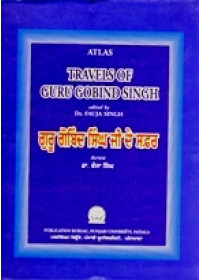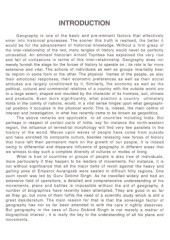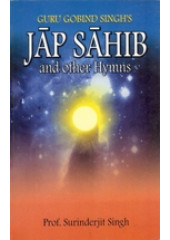Monday to Saturday - 10:00 Am to 9 PM
Now Enjoy Bulk Discounts on Books as Mentioned Below
These Discounts are in addition to the Discounts on Individual Books (Visible as Bulk Discount for Books in Cart)
Extra 10% Off If Books Purchased Exceeds Rs 3000 or 75 USD or 60 GBP or 60 Euro or 100 AUD or 100 CAD
Extra 15% Off If Books Purchased Exceeds Rs 6000 or 150 USD or 120 GBP or 120 Euro or 200 AUD or 200 CAD
Extra 20% Off If Books Purchased Exceeds Rs 15000 or 225 USD or 180 GBP or 180 Euro or 300 AUD or 300 CAD
Extra 25% Off If Books Purchased Exceeds Rs 30000 or 300 USD or 240 GBP or 240 Euro or 400 AUD or 400 CAD
Introduction to the Book 'Travels of Guru Gobind Singh' By Dr. Fauja Singh
Geography is one of the basic and pre-eminent factors that effectively enter into historical processes. The sooner this truth is realised, the better it would be for the advancement of historical knowledge. Without a firm grasp of the inter-relationship of the two, many tangles of history would never be perfectly unravelled. An eminent historian Arnold Toynbee has explained the very rise and fall of civilzations in terms of this inter-relationship. Geography does not merely furnish the stage for the forces of history to operate on; its role is far more extensive and vital. The actions of individuals as well as groups invariably bear its imprint in some form or the other. The physical frames of the people, as also their emotional responses, their economic preferences as well as their social attitudes are largely conditioned by it. Similarly, the economy as well as the political, cultural and commercial relations of a country with the outside world are to a large extent, shaped and moulded by the character of its frontiers, soil, climate and products. Even more significantly, what position a country ultimately holds in the comity of nations, would, in a vital sense hinges upon what geographical position it occupies in the physical world. This is, indeed, the main centre of interest and investigation, in what has recently came to be known as geopolitics.
The above remarks are applicable to all countries including India. But perhaps in respect of certain parts of India, say for instance the north-western region, the influence of terrestrial morphology will find very few parallels in the history of the world. Waves upon waves of people have come from outside and have enriched its composite culture, besides releasing new forces of history that have left their permanent mark on the growth of our people. It is indeed owing to differential and disparate influence of geography in different areas that we witness to-day such a complete diversity of cultures or modes of living.
What is true of countries or groups of people is also true of individuals, more particularly if they happen to be leaders of movements. For instance, it is not without significance that all the major belts of revolt against the heavy and galling yoke of Emperor Aurangzeb were seated in difficult hilly regions. One such revolt was led by Guru Gobind Singh. As he travelled widely and had an extensive field of operations, a detailed and comprehensive understanding of his movements, plans and battles is impossible without the aid of geography. A number of biographies have recently been attempted. They are good in so far as they go, but none of them fulfils the need of a scientific study which is still a great desideratum. The main reason for that is that the sovereign factor of geography in the case of Guru Gobind Singh is not merely a matter of biographical interest ; it is really the key to the understanding of all his plans and movements.
FOREWORD
Guru Gobind Singh, the Tenth Sikh Master, has implanted a lasting stamps on human history. The revolutionary movement, which had gradually evolved under the leadership of the preceding Sikh Gurus, reached its culmination under him. The Khalsa under him had to face a formidable challenge from its adversaries, the Hindu Rajas. He was, therefore, forced to fight against them and naturally could not lead a well-settled life. He was born at Patna in A. D. 1666. He was hardly six years when he left for Anandpur. After some years stay at Anandpur, he proceeded to the State of Nahan and had his headquarters at Paonta for over four years. Towards the end of 1688, he returned to Anandpur where he stayed on till 1705. After leaving Anandpur, he moved into the interior of the Malwa where he travelled widely. Towards the end of 1706 he set out for the Deccan with a view to meeting Emperor Aurangzeb at the latter's invitation. His journey lay through Rajasthan. When he had gone as far as Baghaur, he was apprised of the Emperor's death. Immediately, he obandoned the idea of proceeding any further and turned towards Delhi with the object of meeting Prince Muazzim and watching, as he says in his autobiography, the 'Sultani' war. After a few days stay at Delhi, he moved on to Agra where he was received in royal audience by the vicotrious Prince Muazzim, now Emperor Bahadur Shah. After a few months when the Emperor set out for Rajasthan, the Guru also decided to go along with him. This was his second visit to the land of the Rajputs. The Emperor soon had to march towards the Daccan. The Guru proceeded with him up to Nander, a place on the Godavari bank, where he separated from the Imperial Camp. This was the last place visited by him, for he breathed his last soon afterwards in October, 1708.
Cosequently, while formulating plans for the celebration of the tercentenary of Guru Gobind Singh, it was decided to bring out a detailed atlas of his travels having a separate map of each major movement along with an explanatory note bearing on it. Though the work started immediately, it could not be brought out at the time of celebrations, because the project had to be carried out with great care. I am well aware that despite every possible care there may still be some shortcomings in the present work. But this is only a pioneer attempt and perfection cannot be expected in a pioneer work.
Here I must mention that this work is the result of a corporate effort of Dr. Ganda Singh, Dr. Fauja Singh, S. Mehar Singh Gill and S. Hazara Singh. I shall be failing in my duty if I do not thank them.
| KIRPAL SINGH NARANG | |
| 26 January, 1968 | Vice-Chancellor |
| Punjabi University, Patiala |
Travels of Guru Gobind Singh - Book By Dr. Fauja Singh
- Brand: Punjabi-University-Patiala
- Product Code: SGE151
- Availability: In Stock
-
Rs.300.00
Related Products
Guru Gobind Singhs Jap Sahib and Other Hymns - Book By Prof. Surinderjit Singh
Summary of 'Guru Gobind Singh's Jap Sahib and Other Hymns' By Prof. Surinderjit Singh I..
Rs.70.00
Sikh Shrines in Delhi - Book By Amrik Singh
From the Backcover of 'Sikh Shrines in Delhi' By Amrik Singh Though Sikhs are mainly concentr..
Rs.375.00
The Hanging Of Bhagat Singh - Book By Professor Malwinderjit Singh Waraich , Dr. Gurdev Singh Sidhu
The Hanging Of Bhagat Singh-Book by Professor Malwinderjit Singh Waraich , Dr. Gurdev Singh Sidhu ..
Rs.495.00
Tags: books guru gobind singh, books on sikh gurus, books on teachings of guru nanak, sakhis of sikh gurus, teachings of guru gobind singh, teachings of sikh gurus travels, dr., fauja, english






